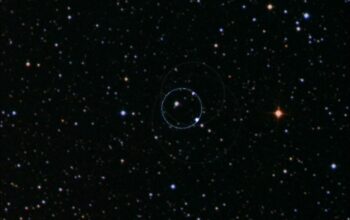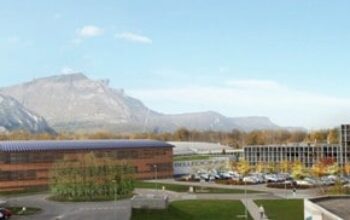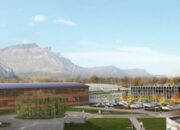In the pantheon of modern scientific endeavors, the construction of an expansive underground neutrino laboratory epitomizes humanity’s quest to probe the enigmas of the universe. Deep within China’s vast geological formations, this laboratory is designed specifically for the study of neutrinos, elusive particles that traverse both time and space with an astonishing ability to evade interaction with ordinary matter. The sheer scale of the project beckons admiration, yet it also prompts contemplation: why are scientists so fascinated by the invisible world of neutrinos, and how does the existence of such a facility evoke a sense of intrigue akin to ghost hunting?
The fascination with neutrinos stems primarily from their fundamental role in the fabric of the universe. These nearly massless particles are generated in the heart of stars, during supernova explosions, and even in the decay of radioactive elements. Despite their abundance—millions of neutrinos pass through our bodies every second—interacting with them is extraordinarily challenging due to their weak interaction with matter. As a result, a dedicated endeavor such as this laboratory becomes a crucible for scientific inquiry into the properties and behaviors of these fascinating subatomic entities.
The importance of the neutrino extends beyond mere curiosity. These particles are key to understanding some of the most profound questions in astrophysics and cosmology. They play a critical role in the process of nuclear fusion in stars, influencing their life cycles and the evolution of galaxies. Furthermore, neutrinos are instrumental in our comprehension of fundamental forces and phenomena, such as the asymmetry between matter and antimatter. Analyzing the properties of neutrinos may yield clues about why the universe is predominantly composed of matter, an enduring mystery of modern physics.
China’s subterranean neutrino laboratory is not merely an academic initiative; it serves as a testament to a global scientific commitment to unraveling the complexities of particle physics. This ambitious project is designed to minimize cosmic noise and environmental interference, allowing for unprecedented measurements of neutrino properties. The facility comprises extensive underground chambers, shielded from the myriad of background radiation present on the surface. By constructing the laboratory in such a secluded location, scientists can create optimal conditions for neutrino detection, enhancing the precision of their experiments.
This endeavor also invites comparisons to ghost hunting. The parallels are not merely superficial; both fields engage with the elusive and the mysterious. Much like ghost hunters, who often operate in environments saturated with anecdotal history and anecdotal evidence of the supernatural, neutrino researchers operate in a realm where detection is fraught with uncertainty. Just as ghost hunters utilize sophisticated equipment in an attempt to capture fleeting phenomena, physicists employ cutting-edge technology, such as highly sensitive detectors and advanced data analysis techniques, to discern the faintest signals emitted by neutrinos.
The metaphor of ghost hunting also serves to highlight humanity’s enduring proclivity for seeking the unseen. Throughout history, both science and folklore have grappled with the intangible. In ancient times, celestial bodies were often interpreted as divine omens. Today, scientists endeavor to comprehend the universe through empirical methodologies, bringing light to the dark corners of existence previously relegated to the domain of superstition. The pursuit of neutrinos signifies a modern form of this age-old quest to unveil the hidden truths lurking in the cosmos.
The establishment of a neutrino laboratory in China reinforces the nation’s burgeoning status as a global leader in scientific research and technological innovation. The project embodies China’s aspirations to contribute fundamentally to our understanding of particle physics and to redefine its role in the global scientific community. Collaborations between Chinese physicists and international partners foster a cooperative spirit that transcends borders and ideologies, galvanizing a collective pursuit of knowledge.
Moreover, the construction of this facility is an exercise in engineering prowess. Designing and implementing an underground laboratory of this magnitude demands not only scientific expertise but also remarkable feat of engineering and construction. The geological assessments and logistical challenges associated with such a project highlight the necessity for interdisciplinary collaboration. Experts in geology, physics, engineering, and environmental science must converge, pooling their knowledge to create an environment conducive to cutting-edge research.
In essence, the underground neutrino lab is more than a building; it is a beacon of potential scientific discovery, reflecting humanity’s instinctual drive to explore the unknown. It beckons to researchers, inviting them on a journey into the very fabric of reality. This venture embodies the spirit of inquiry that underpins both scientific exploration and the myths that tantalize the human imagination.
To delve into the mysteries of neutrinos is to connect with the very essence of what it means to be human—our relentless wonder at the universe, our drive to uncover that which lies hidden. As we continue to push the boundaries of knowledge, the realms of science and the spectral whispers of folklore may find common ground, unveiling truths that resonate deeply within us all. In the quest for understanding, ghost hunters and physicists alike unite in their pursuit of what lies beyond the veil of the visible, challenging our perceptions and deepening our appreciation for the complexity of existence.










